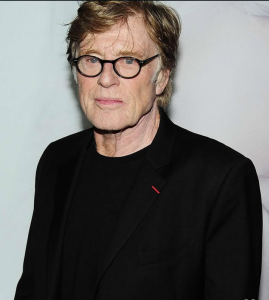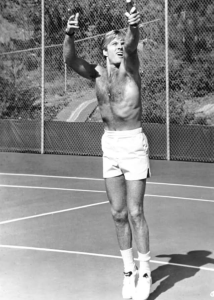Robert Redford Biography: Charles Robert Redford Jr. stands as one of the most enduring and influential figures in American cinema. Born on August 18, 1936, in Santa Monica, California, he has transcended his initial status as a matinee idol to become an Academy Award-winning director, environmental activist, and the founder of the Sundance Film Festival—one of the most important platforms for independent filmmaking in the world. At 89 years old, Redford’s legacy encompasses not just his iconic performances but his transformative impact on the film industry and his unwavering commitment to environmental and social causes.
Robert Redford Biography
Robert Redford Early Life and Formative Years
Robert Redford was born on August 18, 1936, in Santa Monica, California, to Charles Robert Redford, an accountant for Standard Oil, and Martha Redford. His childhood was marked by a rebellious streak that would later inform his choice of unconventional roles and his willingness to challenge Hollywood norms.
Charles Robert Redford, Jr. was a scrappy kid who stole hubcaps in high school and lost his college baseball scholarship at the University of Colorado because of drunkenness. However, beneath this rough exterior lay artistic talent. As a high school student, he had displayed a certain aptitude as a caricaturist, hinting at the creative path that would eventually define his life.
The young Redford’s restless spirit led him on a journey of self-discovery that took him far from his California roots. After years of drifting and studying art in both Europe and the United States, Redford enrolled at the American Academy of Dramatic Arts. This decision marked the beginning of his transformation from a directionless youth into one of America’s most celebrated actors and filmmakers.

Robert Redford Broadway Beginnings and Early Television Work
Soon after enrolling at the American Academy of Dramatic Arts, Redford made his Broadway debut in the play Tall Story (1959). This theatrical beginning provided him with the classical training and stage experience that would ground his later film performances in authenticity and depth.
Landing roles in several television dramas of the early 1960s, such as Alfred Hitchcock productions, Redford honed his craft during television’s golden age. These early television appearances allowed him to work with some of the medium’s most respected directors and helped establish his reputation as a serious actor capable of handling complex dramatic material.
The transition from stage to television to film was gradual but steady, with each medium contributing to his development as a performer. His television work in particular exposed him to a wider audience and demonstrated his versatility across different genres and character types.
Robert Redford Rise to Stardom: The Golden Years of Hollywood
The 1960s and 1970s marked Redford’s emergence as one of Hollywood’s most bankable and charismatic leading men. His breakthrough came with a series of films that not only showcased his acting abilities but also established him as a cultural icon whose appeal transcended traditional movie star boundaries.
His partnership with Paul Newman in “Butch Cassidy and the Sundance Kid” (1969) became one of cinema’s most beloved collaborations. He named the Sundance Film Festival after his character from the movie Butch Cassidy and the Sundance Kid (1969), demonstrating how deeply this role resonated with him personally and professionally.
The success continued with “The Sting” (1973), reuniting him with Newman in a film that would become a classic of American cinema. The only film in which he was completely satisfied with his own performance was The Sting (1973), revealing his perfectionist nature and high standards for his craft.
Throughout this period, Redford carefully chose roles that challenged conventional leading man stereotypes. Films like “All the President’s Men” (1976) showcased his commitment to serious dramatic material and his interest in stories with social and political significance.
Robert Redford Directorial Vision and Critical Success
Redford’s ambitions extended beyond acting to encompass the complete cinematic experience. His directorial debut came with “Ordinary People” (1980), a powerful family drama that demonstrated his ability to handle complex emotional material with sensitivity and skill.
He won the best director Oscar for the family melodrama “Ordinary People” (1980), the first of his nine stints behind the camera. This Academy Award recognition established him as a serious filmmaker and opened doors for a directing career that would span decades.
His directorial work consistently reflected his interests in American history, social justice, and environmental themes. Films like “A River Runs Through It” (1992) and “The Horse Whisperer” (1998) showcased his ability to capture the beauty of the American landscape while telling deeply personal stories about family, tradition, and the human connection to nature.
Robert Redford Personal Life and Family
Redford’s personal life has been marked by both joy and tragedy, experiences that have undoubtedly influenced his artistic choices and philanthropic commitments.
The couple had four children: Scott Anthony Redford (September 1, 1959 – November 17, 1959), Shauna Jean Redford (b. November 15, 1960), David James Redford (May 5, 1962 – October 16, 2020), and Amy Hart Redford (b. October 22, 1970). Scott died of sudden infant death syndrome at the age of just two months, a tragedy that profoundly affected the family.
The loss of his infant son Scott and later the death of his son David James (Jamie) in 2020 at age 58 from cancer brought deep personal grief to Redford’s life. Despite these losses, he has remained close to his surviving children, both of whom have pursued careers in the entertainment industry.
His daughter Amy has followed in his footsteps as a filmmaker and actress, while his daughter Shauna has largely remained out of the public eye. The family values privacy while supporting each other’s professional endeavors and sharing Redford’s commitment to environmental and social causes.
Robert Redford Sundance Revolution
Perhaps no single contribution has had a greater impact on independent cinema than Redford’s creation of the Sundance Institute and Film Festival. Redford’s expansive spirit will live on through the Sundance Institute, a nonprofit organization he founded in 1981 that sponsors the Sundance Film Festival. On the heels of his best-director Oscar, Redford established the nonprofit Sundance Institute in 1980 to help aspiring filmmakers, with workshops starting the following year.
The Sundance Film Festival has become the premier showcase for independent filmmaking in America, launching the careers of countless directors, actors, and producers who might never have found their voice within the traditional Hollywood system. Robert Redford was instrumental to two revolutions: the New Hollywood revival of the 1970s and the independent film boom of the 1990s.
Despite selling the 2,600-acre Sundance Mountain Resort in 2020, he still owns about 1,800 acres in the area, maintaining his connection to the Utah mountains that have been central to both his personal life and his festival’s identity.
Robert Redford Environmental Activism and Social Causes
Beyond his contributions to cinema, Redford has been a passionate advocate for environmental protection and social justice throughout his career. Redford supported environmentalism, Native American rights, LGBT rights, and the arts. He was a supporter of advocacy groups like the Political Action Committee of the Directors Guild of America.
His environmental activism has been deeply personal, stemming from his love of the American West and his concern about the impact of development and climate change on natural landscapes. He has used his celebrity status to draw attention to environmental issues and has been a vocal critic of policies that prioritize short-term economic gain over long-term environmental sustainability.
He also had a property in Santa Fe, New Mexico, where he has spent considerable time away from the Hollywood spotlight, engaging with local communities and environmental organizations.
Robert Redford Recognition and Awards
Redford’s contributions to cinema and society have been recognized with numerous prestigious awards and honors. He received numerous accolades including an Academy Award; a BAFTA Award; and five Golden Globe Awards, as well as the Cecil B. DeMille Award in 1994; the Screen Actors Guild Life Achievement Award in 1996; the Academy Honorary Award in 2002; the Kennedy Center Honors in 2005; the Presidential Medal of Freedom in 2016; and the Honorary César in 2019. He was named by Time as one of the 100 most influential people in the world in 2014.
The Presidential Medal of Freedom, awarded by President Barack Obama in 2016, represents the highest civilian honor in the United States and acknowledges not just his artistic achievements but his lifelong commitment to public service and environmental advocacy.
Robert Redford Acting Philosophy and Approach
Dislikes watching his own films, Redford has always maintained a complex relationship with his own stardom. This self-critical nature has driven him to continuously challenge himself and avoid the trap of resting on his considerable achievements.
His approach to acting has always emphasized authenticity over technique, and he has consistently chosen projects that align with his personal values and interests. Whether playing a journalist in “All the President’s Men” or a baseball player in “The Natural” (1984), Redford brings a naturalistic style that makes his characters feel like real people rather than movie stars playing roles.
Robert Redford Later Career and Continued Influence
Even in his later years, Redford has continued to take on challenging roles and support innovative filmmaking. His performance in “All Is Lost” (2013), a largely wordless survival drama, demonstrated his willingness to take creative risks well into his seventies.
As an octogenarian, Redford has focused increasingly on his legacy through the Sundance Institute while remaining selective about his acting and directing projects. His influence on American cinema extends far beyond his own performances to encompass the countless filmmakers he has supported and the independent film movement he helped create.
Robert Redford Impact on Modern Cinema
Redford’s influence on modern cinema cannot be overstated. As an actor, he helped define a new type of leading man—one who could be both romantically appealing and intellectually serious. As a director, he demonstrated that stars could successfully transition behind the camera and create meaningful, personal films.
Through Sundance, he fundamentally altered the landscape of American filmmaking by providing a platform for voices that the major studios might never have supported. Many of today’s most celebrated filmmakers got their start at Sundance, and the festival continues to be a crucial launching pad for innovative cinema.

Robert Redford Legacy and Continuing Influence
At 89, Robert Redford’s legacy is secure as one of the most important figures in American entertainment history. His contributions span multiple aspects of the industry: as an actor who brought intelligence and authenticity to his roles, as a director who crafted thoughtful and visually stunning films, and as an entrepreneur who revolutionized independent filmmaking.
His environmental activism has inspired generations of entertainers to use their platforms for social good, while his support of independent filmmaking has democratized the industry and given voice to countless storytellers who might otherwise never have been heard.
The Sundance Film Festival continues to thrive as his most enduring institutional legacy, annually showcasing the kind of innovative, personal filmmaking that Redford has championed throughout his career. Through this platform, his influence on cinema will continue long after his own performing days are over.
Robert Redford represents the best of what American entertainment can be: artistically ambitious, socially conscious, and committed to nurturing the next generation of creative voices. His life and career serve as a model for how public figures can use their success and influence to make lasting contributions to both their industry and society as a whole.
Frequently Asked Questions (FAQ)
When and where was Robert Redford born?
Robert Redford was born Charles Robert Redford Jr. on August 18, 1936, in Santa Monica, California.
How did Robert Redford get started in acting?
After studying art in Europe and the United States, he enrolled at the American Academy of Dramatic Arts and made his Broadway debut in “Tall Story” (1959).
What is Robert Redford’s most famous film partnership?
His partnership with Paul Newman in “Butch Cassidy and the Sundance Kid” (1969) and “The Sting” (1973) became one of cinema’s most beloved collaborations.
Why did he name the Sundance Film Festival after his character?
He named the festival after his character from “Butch Cassidy and the Sundance Kid” (1969), a role that clearly had deep personal significance for him.
When did Robert Redford win his Academy Award for directing?
He won the Best Director Oscar for “Ordinary People” (1980), his directorial debut.
When was the Sundance Institute founded?
The Sundance Institute was established in 1980/1981, with workshops beginning in 1981.
Does Robert Redford like watching his own films?
No, he dislikes watching his own films. The only film he was completely satisfied with his own performance in was “The Sting” (1973).
Conclusion
Robert Redford’s remarkable journey from a rebellious teenager in Santa Monica to one of the most respected figures in American cinema represents far more than a traditional Hollywood success story. His life embodies the evolution of American filmmaking itself, from the studio system of the 1960s through the independent film revolution he helped create and continues to champion.
As an actor, Redford redefined what it meant to be a leading man in American cinema. Unlike the traditional matinee idols of previous generations, he brought intellectual depth and moral complexity to his roles, choosing projects that engaged with serious social and political issues rather than simply entertaining audiences. His performances in films like “All the President’s Men” and “The Candidate” demonstrated that commercial success and artistic integrity need not be mutually exclusive.
His transition to directing with “Ordinary People” proved that his talents extended far beyond his screen presence. The film’s Academy Award success established him as a serious filmmaker and opened the door for a directing career that has consistently reflected his personal values and artistic vision. Through films like “A River Runs Through It” and “The Horse Whisperer,” he has shown a particular gift for capturing the beauty of the American landscape and the complex relationships between people and their environment.
Perhaps most significantly, the creation of the Sundance Institute and Film Festival represents Redford’s most enduring contribution to cinema. By providing a platform for independent filmmakers, he fundamentally democratized the American film industry and gave voice to countless storytellers who might never have been heard within the traditional studio system. The festival’s annual showcase of innovative, personal filmmaking continues to launch careers and shape the direction of American cinema.
His environmental activism and support for social causes demonstrate how public figures can leverage their fame for meaningful change. Redford has never been content to simply entertain; he has consistently used his platform to advocate for the causes he believes in, from environmental protection to Native American rights to support for the arts.
The personal tragedies Redford has faced—the loss of his infant son Scott and the death of his son Jamie in 2020—have undoubtedly shaped his perspective on life and informed his artistic choices. Yet he has channeled his experiences into a deeper commitment to meaningful work and service to others.
At 89, Robert Redford’s legacy is multifaceted and profound. He has influenced American cinema not just through his own performances and films, but through the countless careers he has fostered and the institutional changes he has championed. The Sundance Film Festival alone ensures that his impact on filmmaking will continue for generations to come.
His life story serves as a testament to the possibility of reinvention and growth. From a directionless youth who lost his college scholarship to drinking, he transformed himself into one of America’s most respected artists and activists. His journey demonstrates that success in the entertainment industry can be about more than fame and fortune—it can be about using one’s talents and influence to make a lasting positive impact on both art and society.
Robert Redford represents the best aspirations of American entertainment: the belief that cinema can be both popular and meaningful, that commercial success and artistic integrity can coexist, and that public figures have a responsibility to use their platforms for the greater good. His continuing influence through the Sundance Institute ensures that these values will persist long after his own career has concluded.
